Stormwater Harvested from Permeable Pavements as a Means to Save Potable Water in Buildings
Abstract
1. Introduction
2. Materials and Methods
2.1. Simulation Variables
2.1.1. Rainwater Harvesting Model
2.1.2. Permeable Pavement Model
- Reservoir course: Gravel ASTM #2 and thickness according to design;
- Choker course: Gravel ASTM #57 and thickness equal to 30 mm;
- Bedding course: Gravel ASTM #8 and thickness equal to 30 mm;
2.1.3. Buildings
2.1.4. Cities
2.2. Potable Water Savings
2.2.1. Daily Rainfall
2.2.2. Harvesting Area
2.2.3. Total Water Demand
2.2.4. Rainwater Demand
2.2.5. Infiltration Coefficient
2.2.6. Upper Rainwater Tank
2.2.7. Underground Rainwater Tank
2.3. Hydrologic/hydraulic Design
2.3.1. IDF Equations
2.3.2. Permeable to Impermeable Area Ration (R)
2.3.3. Bottom Drains
2.3.4. Hydrologic/hydraulic Design Method
2.4. Structural Design
2.5. Model Validation
3. Results and Discussion
3.1. Potential for Potable Water Savings
3.1.1. Rainfall Data
3.1.2. Water Consumption
3.1.3. Potable Water Savings
3.2. Hydrologic/hydraulic Design
3.3. Structural Design
3.4. Model Validation
4. Conclusions
Supplementary Materials
Author Contributions
Funding
Institutional Review Board Statement
Informed Consent Statement
Data Availability Statement
Acknowledgments
Conflicts of Interest
Abbreviations
| IPCC | Intergovernmental Panel on Climate Change |
| SUDS | Sustainable Urban Drainage Systems |
| LID | Low Impact Development |
| LCA | Life Cycle Assessment |
| IDF | Intensity-Duration-Frequency |
| AASHTO | American Association of State Highway and Transportation Officials |
| ABCP | Brazilian Association of Portland Cement |
| UFSC | Federal University of Santa Catarina |
| BDMEP | Meteorological Database for Teaching and Research |
| ESAL | Equivalent Single Axle Load |
| CBR | California Bearing Ratio |
| ICPI | Interlocking Concrete Pavement Institute |
| SPT | Standard Penetration Test |
References
- Wasko, C.; Sharma, A. Steeper temporal distribution of rain intensity at higher temperatures within Australian storms. Nat. Geosci. 2015, 8, 527–529. [Google Scholar] [CrossRef]
- Muller, M. Cape Town’s drought: Don’t blame climate change. Nature 2018, 559, 174–176. [Google Scholar] [CrossRef]
- Soriano, É.; De Resende Londe, L.; Di Gregorio, L.T.; Coutinho, M.P.; Santos, L.B.L. Water crisis in são paulo evaluated under the disaster’s point of view. Ambiente E Soc. 2016, 19, 21–42. [Google Scholar] [CrossRef]
- IPCC. Summary for Policymakers. In Climate Change 2013—The Physical Science Basis; Intergovernmental Panel on Climate Change, Ed.; Cambridge University Press: Cambridge, UK, 2014; pp. 1–30. [Google Scholar] [CrossRef]
- IPCC. Climate Change 2014 Mitigation of Climate Change; Cambridge University Press: Cambridge, UK, 2015. [Google Scholar] [CrossRef]
- Hurlimann, A.; Dolnicar, S. Public acceptance and perceptions of alternative water sources: A comparative study in nine locations. Int. J. Water Resour. Dev. 2016, 32, 650–673. [Google Scholar] [CrossRef]
- Curitiba. Decree No. 293 of 22 March 2006. Regulates Law 10,785 of 2003 and Provides on the Criteria for the Rational Use and Conservation of Water in Buildings and Makes Other Provisions. Available online: http://leismunicipa.is/lfkcp (accessed on 17 June 2021).
- Anand, C.; Apul, D.S. Economic and environmental analysis of standard, high efficiency, rainwater flushed, and composting toilets. J. Environ. Manag. 2011, 92, 419–428. [Google Scholar] [CrossRef] [PubMed]
- Ghisi, E.; Rupp, R.F.; Triska, Y. Comparing indicators to rank strategies to save potable water in buildings. Resour. Conserv. Recycl. 2014, 87, 137–144. [Google Scholar] [CrossRef]
- Marinoski, A.K.; Ghisi, E. Aproveitamento de água pluvial para usos não potáveis em instituição de ensino: Estudo de caso em Florianópolis–SC (Rainwater harvesting for non-potable uses in schools: Case study in Florianópolis–SC). Ambiente Construído 2008, 8, 67–84. [Google Scholar]
- Tucci, C.E.M. Urban Stormwater Management (Gestão de Águas Pluviais Urbanas, in Portuguese); Ministério das Cidades: Brasilia, Brazil; Global Water Partnership: Stockholm, Sweden; World Bank: Washington, DC, USA; UNESCO: Paris, France, 2005.
- Agostinho, M.D.S.P.; Poleto, C. Sustainable Urban Drainage Systems: Devices (Sistemas Sustentáveis de Drenagem Urbana: Dispositivos, in portuguese). Holos Environ. 2012, 12, 121. [Google Scholar] [CrossRef][Green Version]
- Scholz, M.; Grabowiecki, P. Review of permeable pavement systems. Build. Environ. 2007, 42, 3830–3836. [Google Scholar] [CrossRef]
- Acioli, L.A. Experimental Study of Permeable Pavements for Surface Runoff Control at Source (Estudo Experimental de Pavimentos Permeáveis para o Controle do Escoamento Superficial na Fonte, in Portuguese). Ph.D. Thesis, Federal University of Rio Grande do Sul (UFRGS), Porto Alegre, Brazil, 2005. [Google Scholar]
- Marchioni, M.; Silva, C.O. Permeable Interlocking Pavement–Best Practices (Pavimento Intertravado Permeável–Melhores Práticas, in Portuguese); Technical Report; Associação Brasileira de Cimento Portland: São Paulo, Portland, 2010. [Google Scholar]
- Pratt, C.J.; Newman, A.P.; Bond, P.C. Mineral oil big-degradation within a permeable pavement: Long term observations. Water Sci. Technol. 1999, 39, 103–109. [Google Scholar] [CrossRef]
- Legret, M.; Colandini, V.; Le Marc, C. Effects of a porous pavement with reservoir structure on the quality of runoff water and soil. Sci. Total Environ. 1996, 189–190, 335–340. [Google Scholar] [CrossRef]
- Bernucci, L.L.B.; da Motta, L.M.G.; Ceratti, J.A.P.; Soares, J.B. Asphalt Paving: Basic Training for Engineers (Pavimentação Asfáltica: Formação Básica para Engenheiros, in Portuguese); PETROBRÁS Asfaltos e ABEDA (Associação Brasileira das Empresas Distribuidoras de Asfaltos): Rio de Janeiro, Brazil, 2008. [Google Scholar]
- Knabben, R.M.; Trichês, G.; Gerges, S.N.Y.; Vergara, E.F. Evaluation of sound absorption capacity of asphalt mixtures. Applied Acoustics 2016, 114, 266–274. [Google Scholar] [CrossRef]
- Hammes, G.; Thives, L.P.; Ghisi, E. Application of stormwater collected from porous asphalt pavements for non-potable uses in buildings. J. Environ. Manag. 2018, 222, 338–347. [Google Scholar] [CrossRef] [PubMed]
- Antunes, L.; Thives, L.; Ghisi, E. Potential for Potable Water Savings in Buildings by Using Stormwater Harvested from Porous Pavements. Water 2016, 8, 110. [Google Scholar] [CrossRef]
- Nirmalaraja, J.; Meyers, B. Use of Permeable Pavement to Stormwater Harvesting and Reuse to irrigate oval at Morphett Vale Sport Complex, South Australia. In Proceedings of the Stormwater 2014 3rd National Conference on Urban Water Management, Adelaide, Australia, 13–17 October 2014. [Google Scholar]
- Kazemi, F.; Hill, K. Effect of permeable pavement basecourse aggregates on stormwater quality for irrigation reuse. Ecol. Eng. 2015, 77, 189–195. [Google Scholar] [CrossRef]
- Antunes, L.N.; Ghisi, E.; Severis, R.M. Environmental assessment of a permeable pavement system used to harvest stormwater for non-potable water uses in a building. Sci. Total Environ. 2020, 746, 141087. [Google Scholar] [CrossRef] [PubMed]
- Martins Vaz, I.C.; Ghisi, E.; Thives, L.P. Life cycle energy assessment and economic feasibility of stormwater harvested from pervious pavements. Water Res. 2020, 170, 115322. [Google Scholar] [CrossRef]
- American Association of State Highways and Transportation Officials. Guide for Design of Pavement Structures; American Association of State Highway and Transportation Officials (AASHTO): Washington, DC, USA, 1993; p. 640. [Google Scholar]
- PMSP (Prefeitura do Município de São Paulo). Interlocking Concrete Pavement Design (Dimensionamento de Pavimentos com Blocos Intertravados de Concreto, in Portuguese); Technical Report; PMSP: São Paulo, Portland, 2004.
- Ghisi, E.; Belotto, T.; Thives, L.P. The use of permeable interlocking concrete pavement to filter stormwater for non-potable uses in buildings. Water 2020, 12, 2045. [Google Scholar] [CrossRef]
- Associação Brasileira De Normas Técnicas (ABNT). NBR 16416: Pervious Concrete Pavement—Requirements and Procedures; ABNT: Rio de Janeiro, Brazil, 2015. [Google Scholar]
- UFSC-Sustentável. Water Consumption Monitoring per Consumer Unit (Monitoramento do Consumo de Água por Unidade Consumidora, in Portuguese); Technical Report; Coordenadoria de Gestão Ambiental (Environmental Management Office): Florianópolis, Brazil, 2019. [Google Scholar]
- Google Earth. Version Google Earth Pro 7.3. Available online: https://www.google.com.br/earth (accessed on 1 August 2019).
- Botelho, A.N. Estimation of Water End-Uses at the Federal University of Santa Catarina. (Estimativa dos Usos Finais de Água Potável na Universidade Federal de Santa Catarina, in Portuguese); UFSC: Florianópolis, Brazil, 2008. [Google Scholar]
- RainMap. Feasibility Analysis of a Rainwater Harvesting System at the Technological Center, Brazil–CTC/UFSC (Análise de Viabilidade para Implantação de um Sistema de Aproveitamento de Águas Pluviais no Centro Tecnológico–CTC/UFSC, in Portuguese); Technical Report; Rainmap: Florianópolis, Brazil, 2017. [Google Scholar]
- IBGE (Instituto Brasileiro de Geografia e Estatística). Cidades@; IBGE: Rio de Janeiro, Brazil, 2019. Available online: https://cidades.ibge.gov.br/ (accessed on 17 June 2021).
- Ghisi, E.; Cordova, M.M. Netuno 4 Programme (Netuno 4, Programa Computacional, in Portuguese); Federal University of Santa Catarina—UFSC, Civil Engineering Department: Florianópolis, Brazil, 2014; Available online: http://www.labeee.ufsc.br/ (accessed on 17 June 2021).
- INMET Meteorological Database. Available online: https://bdmep.inmet.gov.br/ (accessed on 17 June 2021).
- Associação Brasileira De Normas Técnicas (ABNT). NBR 16783: Use of Alternative Sources of Non-Potable Water in Buildings; ABNT: Rio de Janeiro, Brazil, 2019. [Google Scholar]
- Back, A.J. Intense Rainfall and Design Rainfall for Superficial Drainage Structures Design in the State of Santa Catarina (Chuvas Intensas e Chuva para o Dimensionamento de Estruturas de Drenagem para o Estado de Santa Catarina, in Portuguese); EPAGRI: Florianópolis, Brazil, 2013. [Google Scholar]
- Souza, J.C.B.; Azevedo, J.R.G. IDF Versus Design Water Flow of an Urban Drainage System. (Curvas IDF Versus Vazão de Projeto de um Sistema de Drenagem Urbana, in Portuguese); Associação Brasileira de Recursos Hídricos: Porto Alegre, Brazil, 2015. [Google Scholar]
- CPRM (Companhia de Pesquisa de Recursos Minerais); Adriana Burin Weschenfelder, K.P.; Pinto, E.J.D.A. Pluviometric Atlas of Brazil, Intensity-Duration-Frequency Equations. City: Porto Alegre (Atlas Pluviométrico do Brasil, Equações Intensidade-Duração-Frequência. Município: Porto Alegre, in Portuguese). Estação Pluviográfica: Porto Alegre, Códigos 0305101; Technical Report; CPRM: Porto Alegre, Brazil, 2015.
- Silva, D.D.; Valverde, A.E.L.; Pruski, F.F.; Gonçalves, R.A.B. Parameter estimation and spatialization in the rainfall intensity-duration-frequency equation for the state of São Paulo (Estimativa e espacialização dos parâmetros da equação intensidade-duração-frequência da precipitação para o estado de São Paulo. Eng. Nat. Agric. 1999, 7, 70–87. [Google Scholar]
- Agência Reguladora de Águas, Energia e Saneamento Básico do Distrito Federal (ADASA). Federal District Urban Drainage Plan–PDDU/DF (Plano Diretor de Drenagem Urbana do Distrito Federal—PDDU/DF, in Portuguese); Technical Report; ADASA: Brasília, Brazil, 2016.
- Fendrich, R. Intense Rainfall for Drainage Structures in Parana State (Chuvas Intensas para Obras de Drenagem no Estado do Paraná, in Portuguese); Champagnat: Curitiba, Brazil, 1998; p. 99. [Google Scholar]
- CPRM (Companhia de Pesquisa de Recursos Minerais); De Azambuja, A.M.S.; Pinto, E.J.D.A. Pluviometric Atlas of Brazil, Intensity-Duration-Frequency Equations. City: Rio Branco do Sul-Santa Cruz-Tigre, Code 02549054. (Atlas Pluviométrico do Brasil; Equações Intensidade-Duração-Frequência, Desagregação de Precipitações Diárias. Município: R; Technical Report; CPRM: Belém, Brazil, 2014.
- Back, Á.; Bonetti, A. Design rainfall for stormwater plumbing in Santa Catarina (Chuva de projeto para instalações prediais de águas pluviais de Santa Catarina, in portuguese). Rev. Bras. De Recur. Hidricos 2014, 19, 260–267. [Google Scholar] [CrossRef]
- Freitas, A.J.; Silva, D.D.; Pruski, F.F.; Pinto, F.A.; Pereira, S.B.; Gomes Filho, R.R.; Teixeira, A.F.; Baena, L.G.N.; Mello, L.T.A.; Novaes, L.F. Intense Rainfall Equations in the State of Minas Gerais (Equações de Chuvas Intensas no Estado de Minas Gerais, in Portuguese); Companhia de Saneamento de Minas Gerais: Belo Horizonte, Brazil; Universidade Federal de Viçosa: Viçosa, Minas Gerais, Brazil, 2001; 65p. [Google Scholar]
- TSM (Tennessee Stormwater Management). Permeable Pavement. In Tennessee Permanent Stormwater Management and Design Guidance Manual; Tennessee Department of Environment and Conservation—Division of Water Resources: Nashville, TN, USA, 2015; pp. 187–214. [Google Scholar]
- Plinio Tomaz Engenharia. Diffuse Pollution: Porous Pavements. Stormwater Management Course (Poluição Difusa: Pavimento Poroso. Curso de Manejo de águas Pluviais, in Portuguese); Plínio Tomaz: Guarulhos, Brazil, 2019. [Google Scholar]
- Eisenberg, B.; Lindow, K.C.; Smith, D.R. Permeable Pavements; American Society of Civil Engineers: Reston, VA, USA, 2015. [Google Scholar]
- Buchanan, S. Resilient Modulus: What, Why and How? Vulcan Materials Company: Naperville, IL, USA, 2007; pp. 1–13. [Google Scholar]
- ICPI. Permeable Design Pro; Interlocking Concrete Pavement Institute, Developed by Applied Research Associates, Inc.: Chantilly, VA, USA, 2019. [Google Scholar]
- Soares Geraldi, M.; Ghisi, E. Assessment of the length of rainfall time series for rainwater harvesting in buildings. Resour. Conserv. Recycl. 2018, 133, 231–241. [Google Scholar] [CrossRef]
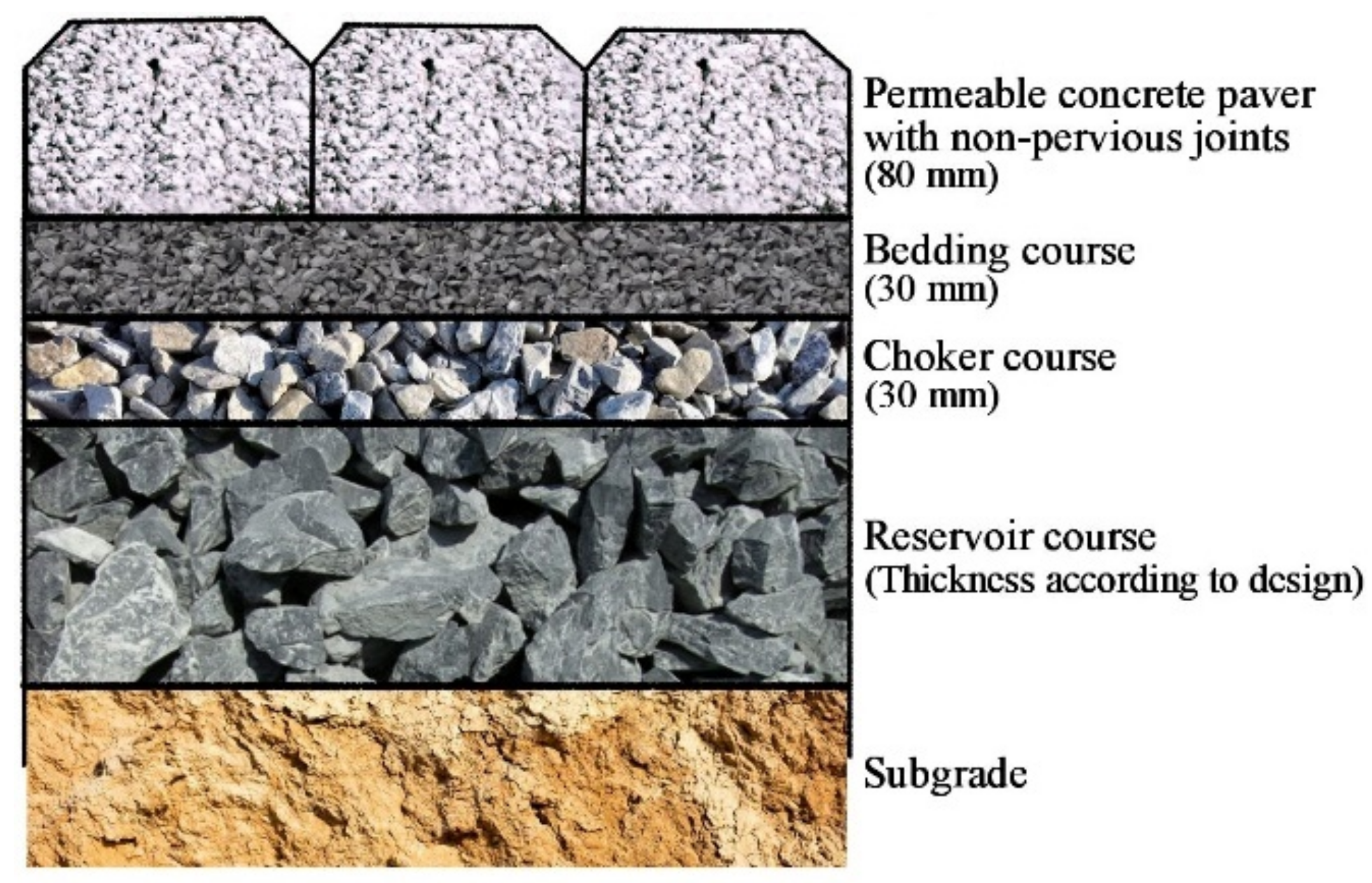
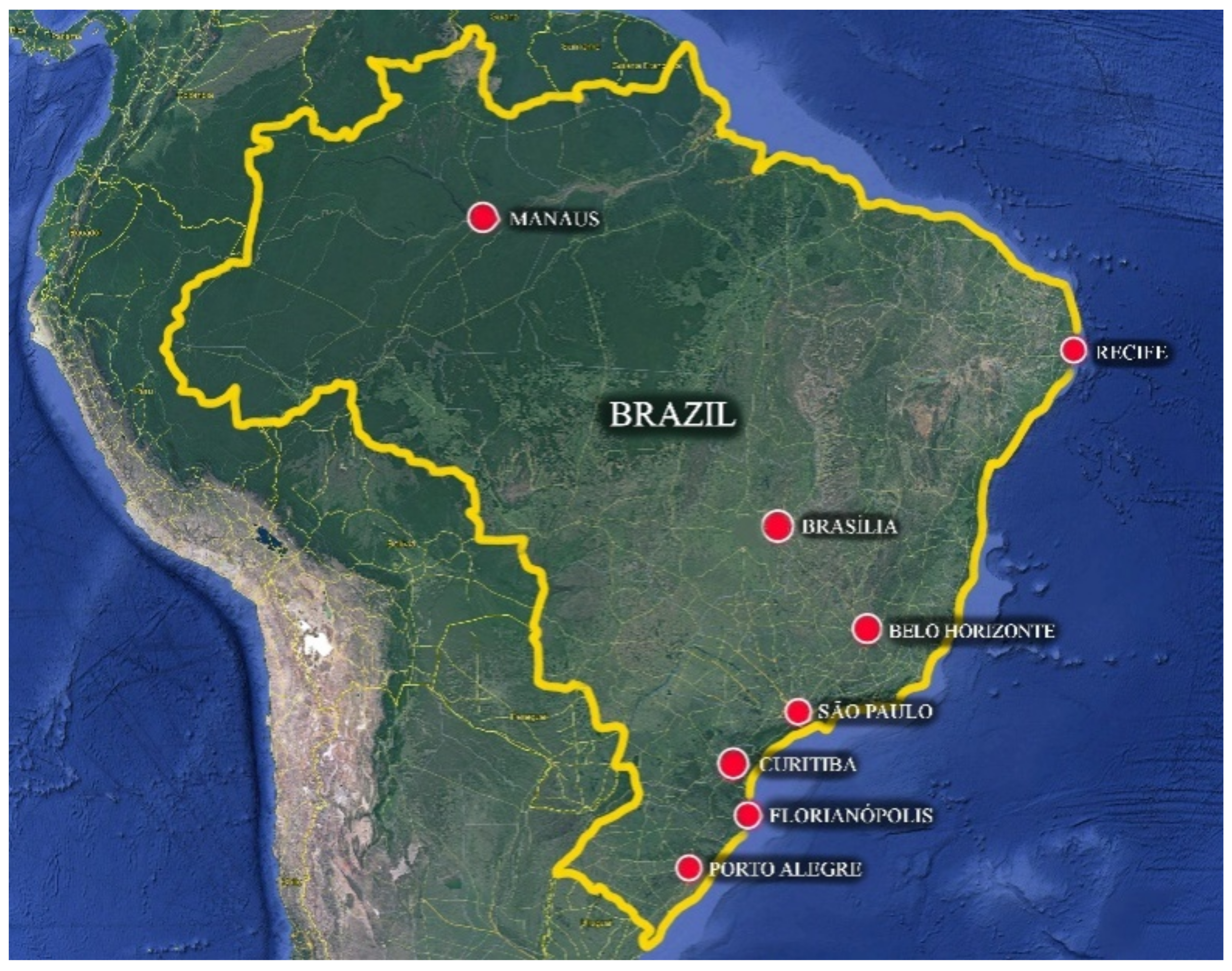
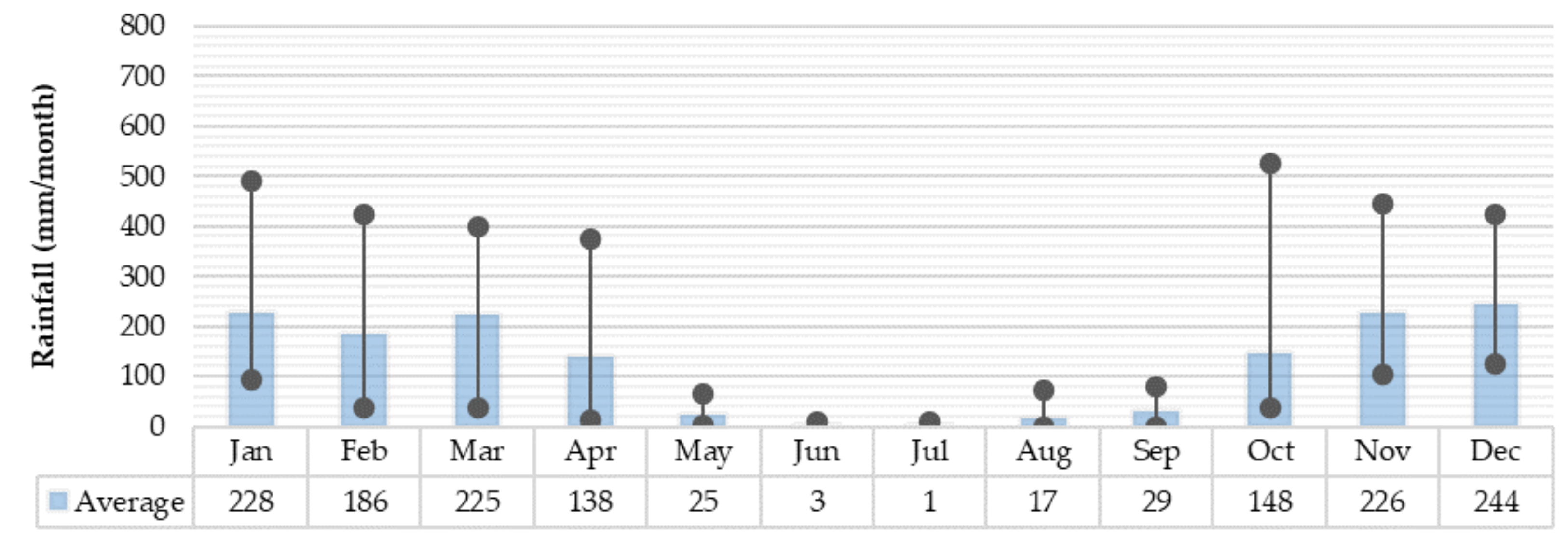
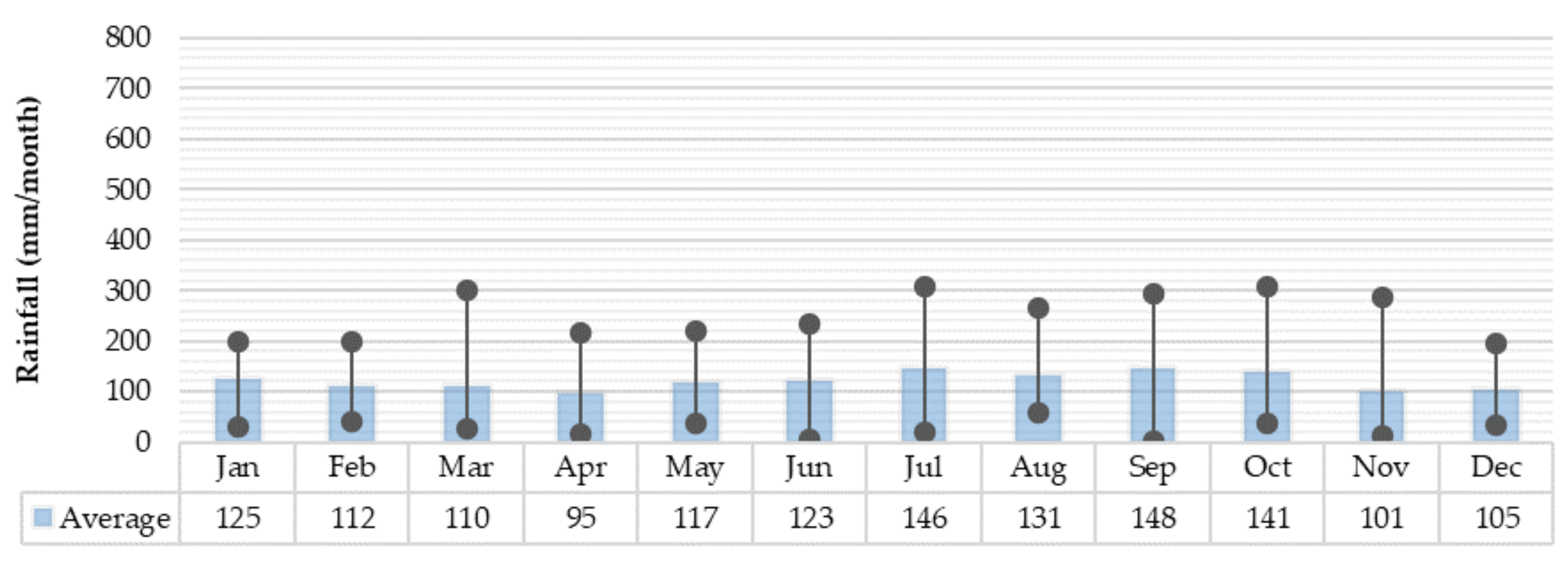

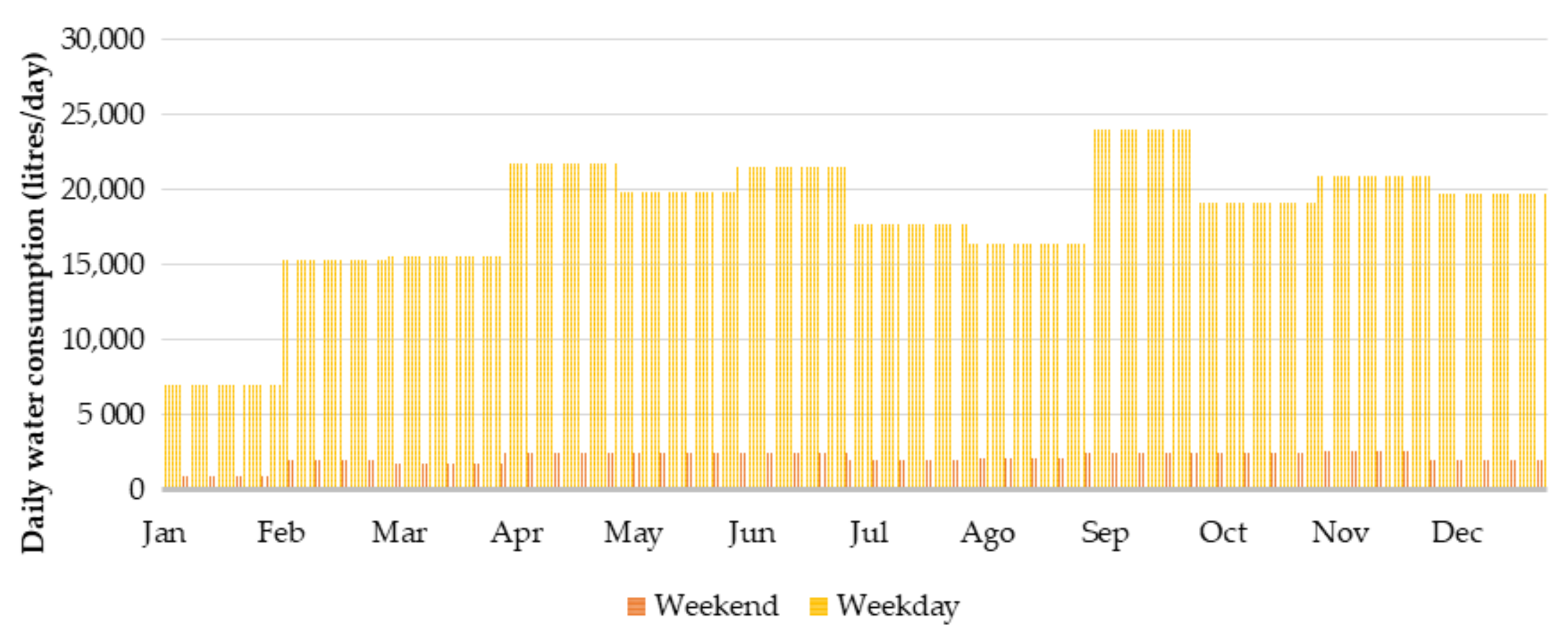
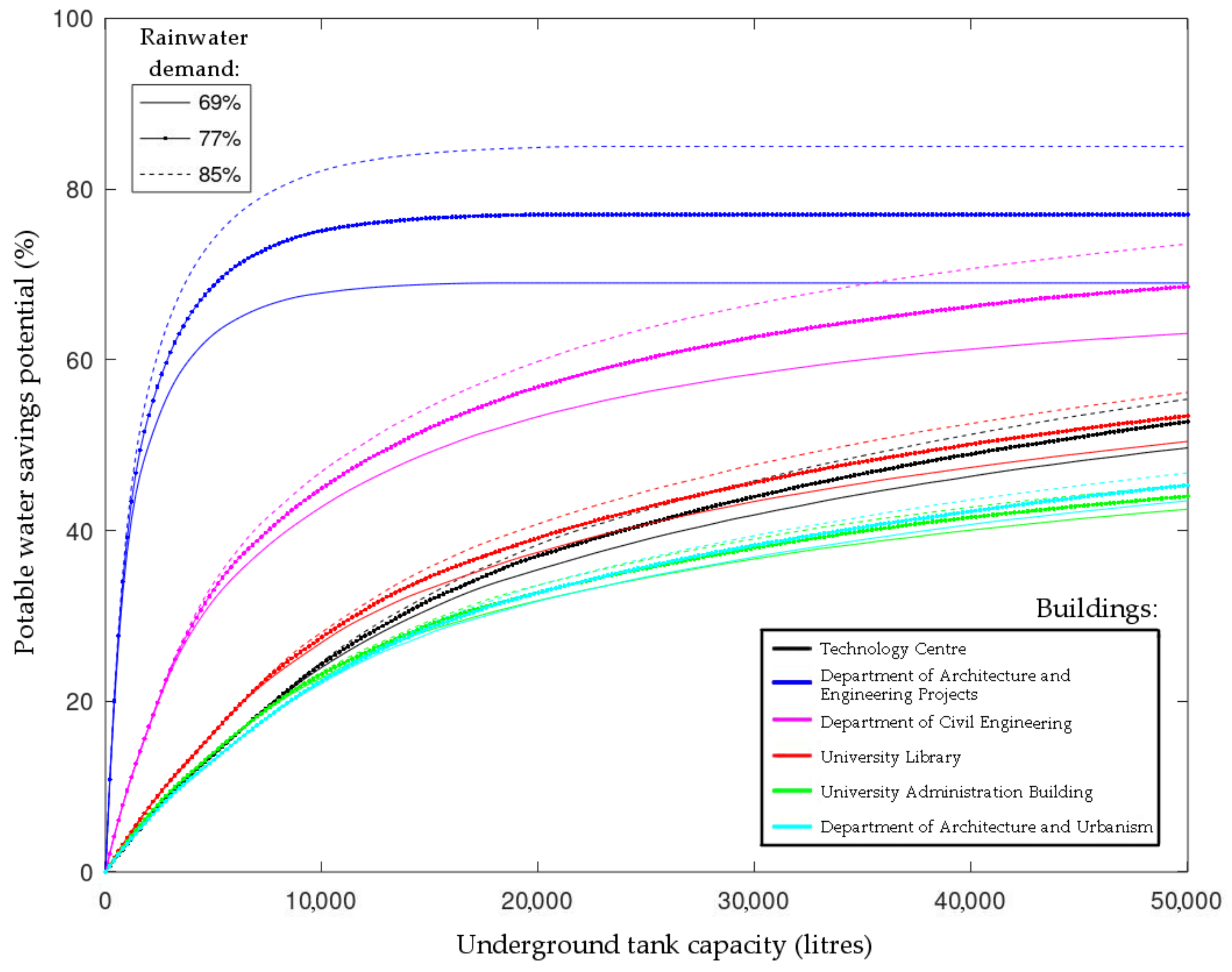
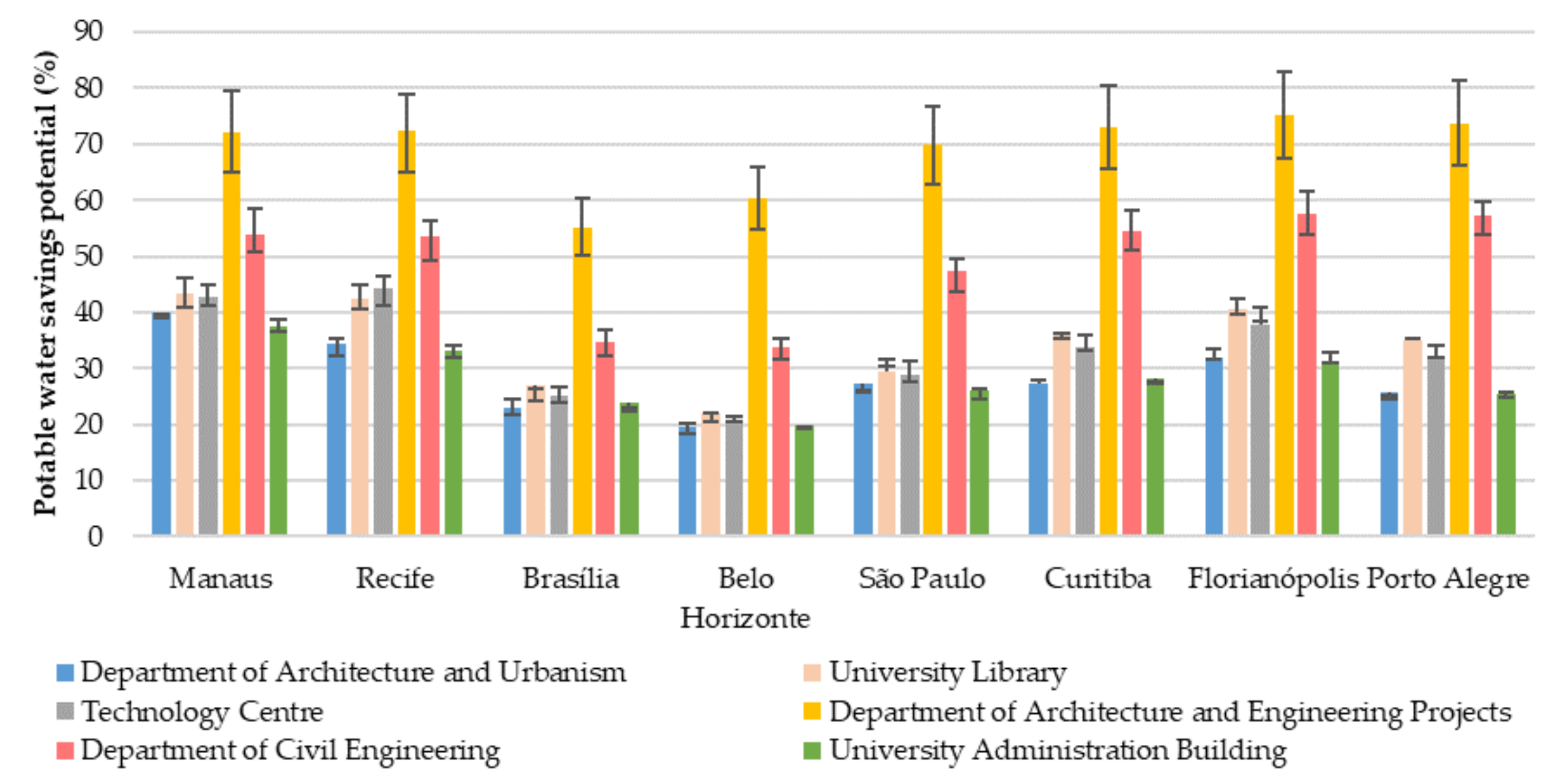
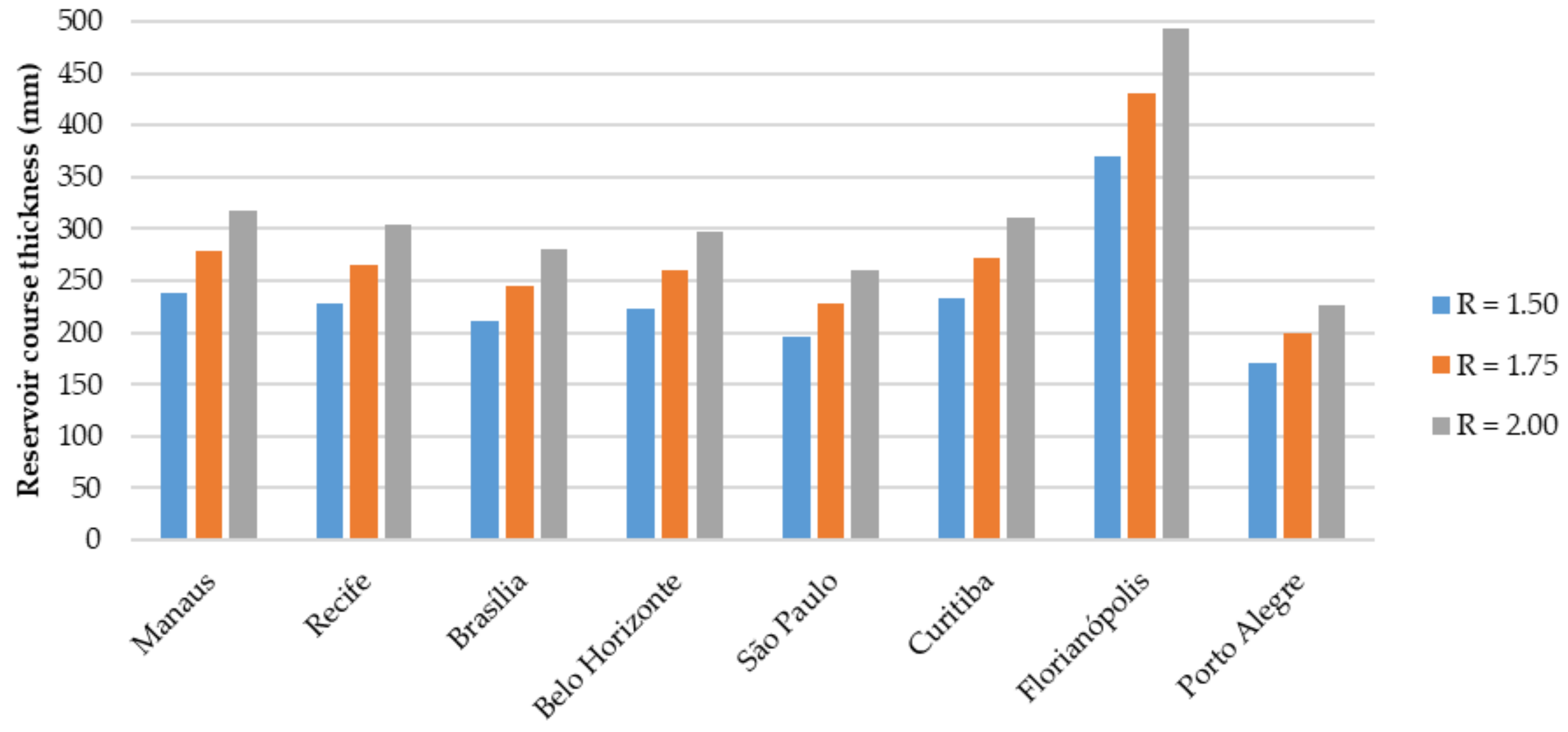
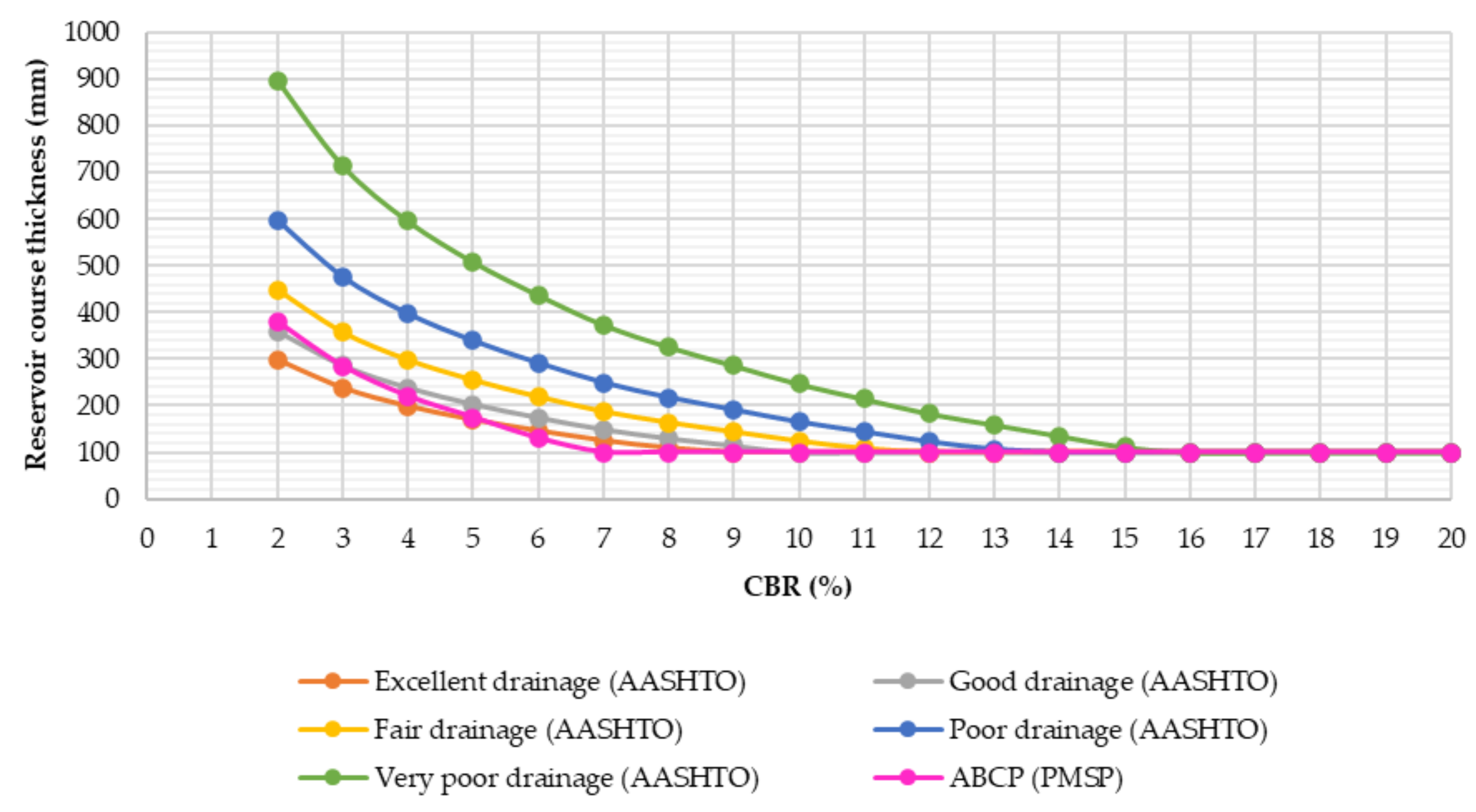
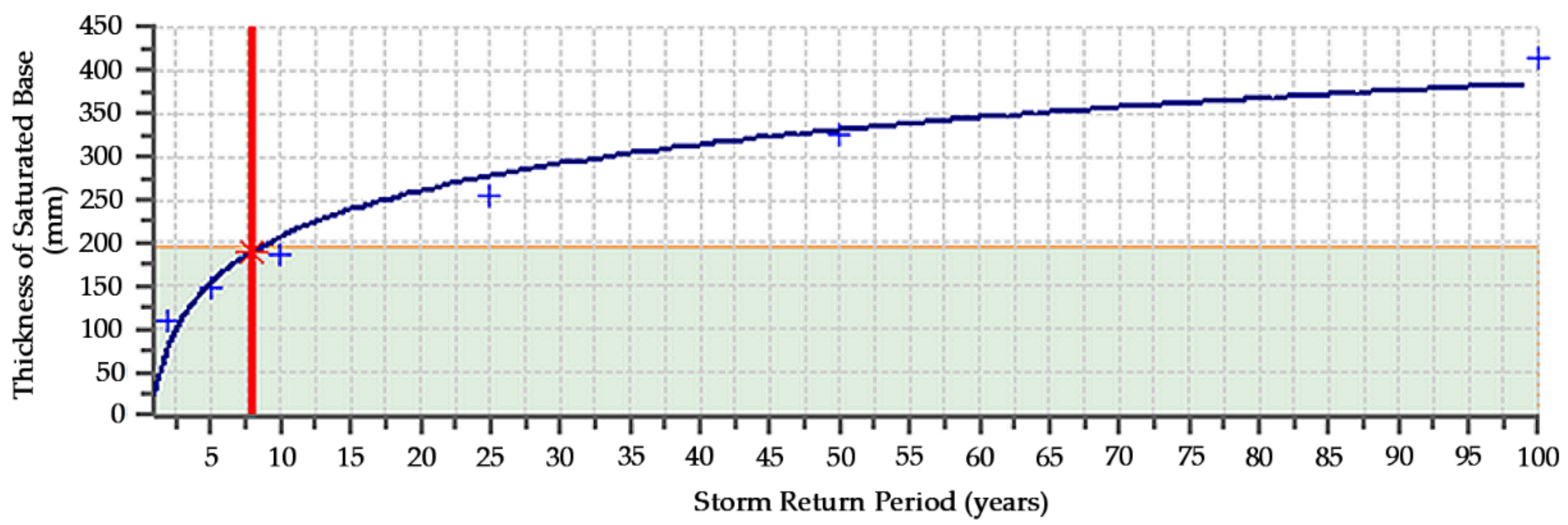
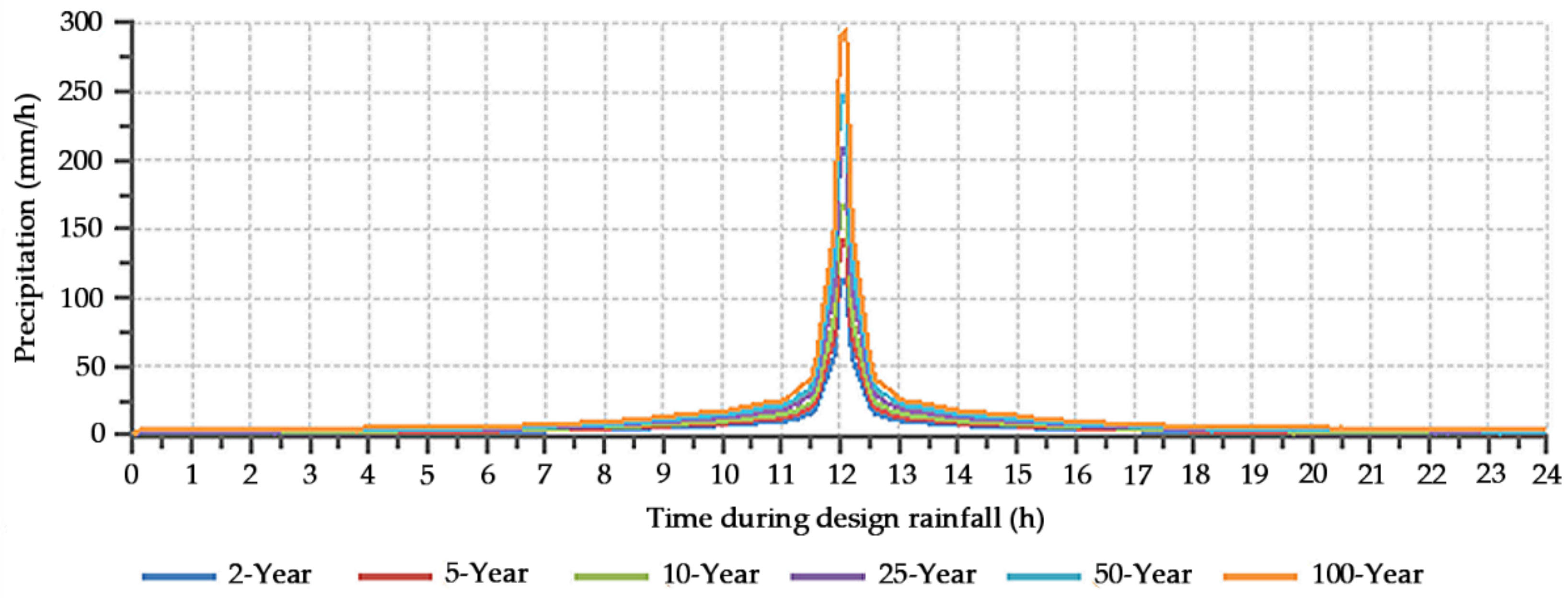
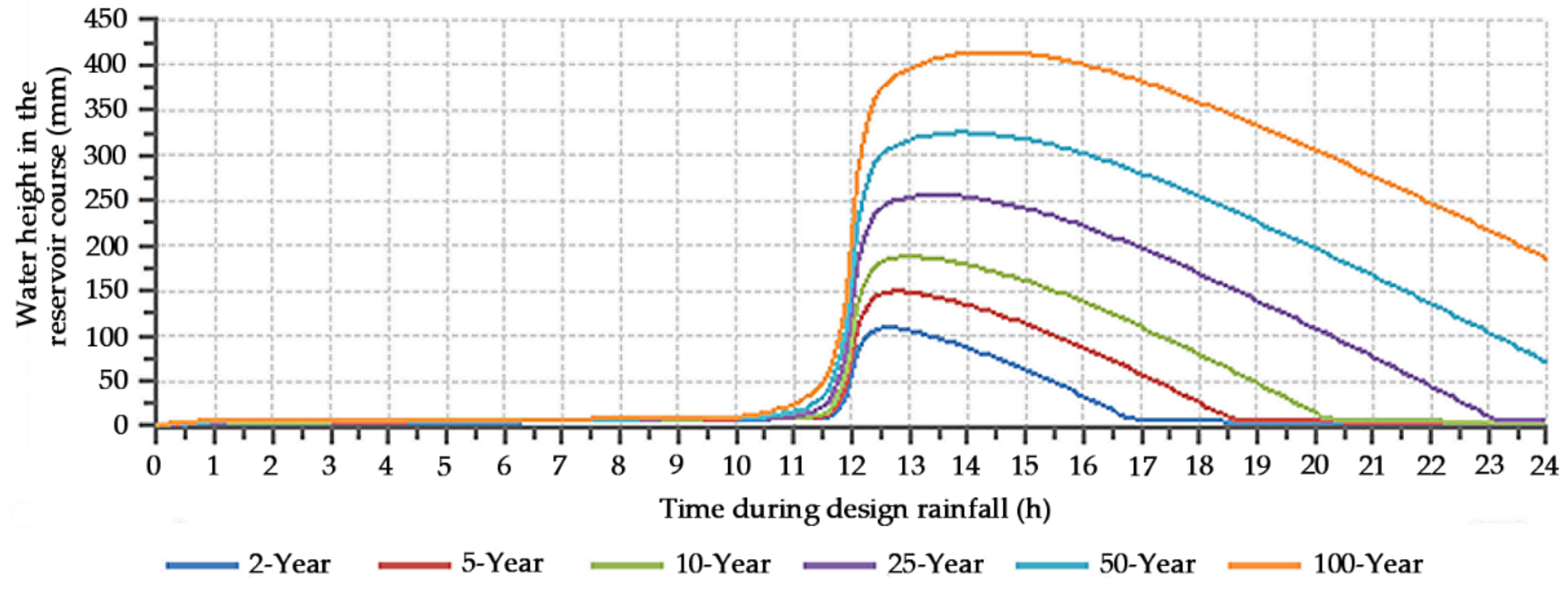
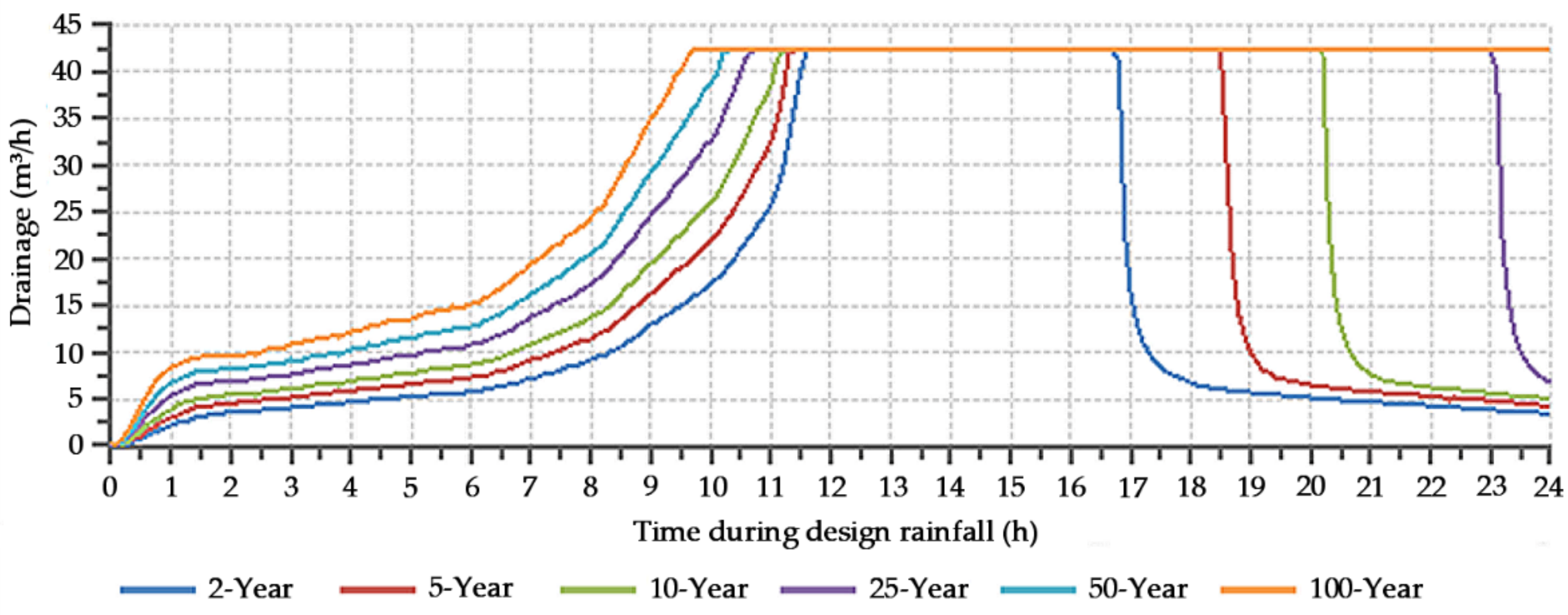
| Building | Parking Lot Area (m2) | Water Consumption (L/Year) |
|---|---|---|
| University Library | 3150 | 3899 |
| Department of Civil Engineering | 1600 | 1540 |
| Department of Architecture and Engineering Projects | 1750 | 322 |
| Department of Architecture and Urbanism | 2050 | 4541 |
| University Administration Building | 1650 | 4089 |
| Technology Centre | 5500 | 4953 |
| City | Population | Area (Km2) | Latitude | Longitude |
|---|---|---|---|---|
| Manaus | 2,182,763 | 11,401.092 | −3.10719 | −60.0261 |
| Recife | 1,645,727 | 218.843 | −8.05428 | −34.8813 |
| Brasília | 3,015,268 | 5760.783 | −15.7801 | −47.9292 |
| Belo Horizonte | 2,512,070 | 331.401 | −19.8157 | −43.9542 |
| São Paulo | 12,252,023 | 1521.110 | −23.5489 | −46.6388 |
| Curitiba | 1,933,105 | 435.036 | −25.4284 | −49.2733 |
| Florianópolis | 500,973 | 674.844 | −27.5969 | −48.5495 |
| Porto Alegre | 1,483,771 | 495.390 | −30.0277 | −51.2287 |
| City | Source | Variables | |||
|---|---|---|---|---|---|
| K | m | d | n | ||
| Manaus | Souza and Azevedo [39] | 1701.340 | 0.110 | 25.00 | 0.798 |
| Recife | CPRM [40] | 4247.900 | 0.210 | 25.20 | 1.120 |
| Brasília | Silva et al. [41] | 1646.120 | 0.128 | 15.72 | 0.856 |
| Belo Horizonte | ADASA [42] | 1574.700 | 0.207 | 11.00 | 0.884 |
| São Paulo | Fendrich [43] | 5950.000 | 0.217 | 26.00 | 1.150 |
| Curitiba | CPRM [44] | 3221.070 | 0.258 | 26.00 | 1.010 |
| Florianópolis | Back and Bonetti [45] | 1168.500 | 0.238 | 9.10 | 0.703 |
| Porto Alegre | Freitas et al. [46] | 682.874 | 0.169 | 3.99 | 0.671 |
| City | Average Annual Rainfall (mm/Year) | Standard Deviation of Monthly Average Rainfall (m3/Month) | Highest Daily Rainfall (mm/Day) |
|---|---|---|---|
| Manaus | 2287 | 100.31 | 142 |
| Recife | 2230 | 124.55 | 150 |
| Brasília | 1469 | 96.12 | 111 |
| Belo Horizonte | 1522 | 113.15 | 156 |
| São Paulo | 1641 | 84.71 | 140 |
| Curitiba | 1584 | 33.49 | 128 |
| Florianópolis | 1789 | 39.79 | 253 |
| Porto Alegre | 1454 | 16.73 | 150 |
| Building | Annual Average Rainfall (mm/Year) | Total Harvesting Area (m2) | Optimal Underground Tank Capacity (m3) for Each Rainwater Demand | ||
|---|---|---|---|---|---|
| 69% | 77% | 85% | |||
| University Library | 1789 | 3150 | 23.0 | 22.0 | 22.0 |
| Department of Civil Engineering | 1600 | 21.0 | 21.0 | 22.0 | |
| Department of Architecture and Engineering Projects | 1750 | 9.0 | 10.0 | 11.0 | |
| Department of Architecture and Urbanism | 2050 | 20.0 | 19.0 | 20.0 | |
| University Administration Building | 1650 | 19.0 | 18.0 | 19.0 | |
| Technology Centre | 5500 | 24.0 | 21.0 | 23.0 | |
| City | Design Rainfall Intensity (mm/h) | Number of Days with Rainfall Greater Than the Design Rainfall (Days) | Highest Rainfall in a Day (mm) |
|---|---|---|---|
| Manaus | 66.4 | 53 | 142.00 |
| Recife | 63.3 | 82 | 149.70 |
| Brasília | 58.6 | 35 | 110.70 |
| Belo Horizonte | 61.9 | 46 | 156.30 |
| São Paulo | 54.4 | 65 | 140.40 |
| Curitiba | 64.9 | 25 | 128.20 |
| Florianópolis | 102.9 | 12 | 253.00 |
| Porto Alegre | 47.4 | 76 | 149.60 |
| Building | Permeable Area (m2) | Impermeable Area (m2) | Total Area (m2) | R |
|---|---|---|---|---|
| Department of Architecture and Engineering Projects | 875 | 875 | 1750 | 2.00 |
| Department of Civil Engineering | 800 | 800 | 1600 | 2.00 |
| University Library | 1575 | 1575 | 3150 | 2.00 |
| Technology Centre | 2750 | 2750 | 5500 | 2.00 |
| University Administration Building | 1100 | 550 | 1650 | 1.50 |
| Department of Architecture and Urbanism | 1160 | 870 | 2030 | 1.75 |
| Parameters | Value | |
|---|---|---|
| Pavers | Thickness | 110 mm |
| Structural coefficient | 0.3 (dimensionless) | |
| Choker course | Thickness | 30 mm |
| Structural coefficient | 0.11 (dimensionless) | |
| Reservoir course | Structural coefficient | 0.08 (dimensionless) |
| Drainage coefficient | 0.4/0.6/0.8/1.0/1.2 | |
| Traffic | (80 kN axle) ESALs | 100,000 (ESALs) |
| Subgrade | CBR (%) | 5 (%) 1 |
| Method considerations | Zr 2 | −0.385 (dimensionless) |
| So 3 | 0.48 (dimensionless) | |
| ΔPSI 4 | 2.2 (dimensionless) | |
| Parameter | Figure Considered | |
|---|---|---|
| Pavers | Permeability (mm/s) | 1.972 |
| Choker course | 0.011 | |
| Reservoir course | 1.014 | |
| Subgrade | 0.000 (impermeable) | |
| Drainage conditions | Daily rainfall distribution | Type III - NRCS |
| Drainage area | Variable | |
| Distance between adjacent drains | 6 m | |
| Drain diameter | 10.0 cm | |
| Drain slope | 0.5 % | |
| Drain roughness coefficient | 0.012 | |
| System’s initial water volume | 0.0 m3 | |
| Maximum water height in the reservoir course | 100.0% | |
Publisher’s Note: MDPI stays neutral with regard to jurisdictional claims in published maps and institutional affiliations. |
© 2021 by the authors. Licensee MDPI, Basel, Switzerland. This article is an open access article distributed under the terms and conditions of the Creative Commons Attribution (CC BY) license (https://creativecommons.org/licenses/by/4.0/).
Share and Cite
Martins Vaz, I.C.; Ghisi, E.; Thives, L.P. Stormwater Harvested from Permeable Pavements as a Means to Save Potable Water in Buildings. Water 2021, 13, 1896. https://doi.org/10.3390/w13141896
Martins Vaz IC, Ghisi E, Thives LP. Stormwater Harvested from Permeable Pavements as a Means to Save Potable Water in Buildings. Water. 2021; 13(14):1896. https://doi.org/10.3390/w13141896
Chicago/Turabian StyleMartins Vaz, Igor Catão, Enedir Ghisi, and Liseane Padilha Thives. 2021. "Stormwater Harvested from Permeable Pavements as a Means to Save Potable Water in Buildings" Water 13, no. 14: 1896. https://doi.org/10.3390/w13141896
APA StyleMartins Vaz, I. C., Ghisi, E., & Thives, L. P. (2021). Stormwater Harvested from Permeable Pavements as a Means to Save Potable Water in Buildings. Water, 13(14), 1896. https://doi.org/10.3390/w13141896








